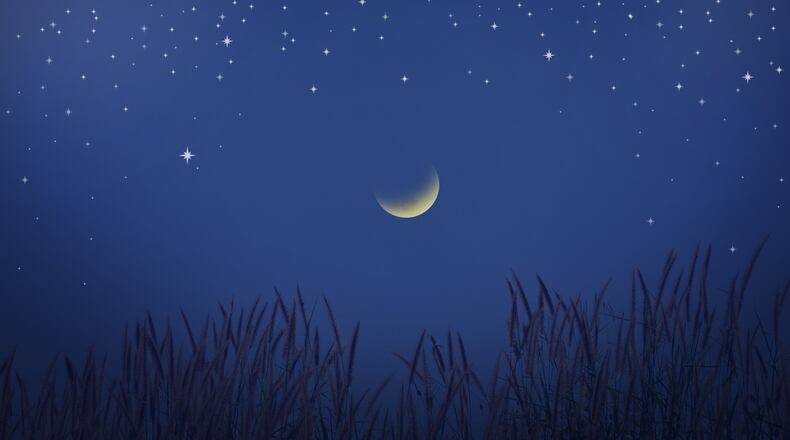The year is dying in the night;
Ring out, wild bells, and let him die.
Ring out the old, ring in the new,
Ring happy bells, across the snow:
The year is going, let him go. — Alfred Lord Tennyson
The likelihood of precipitation increases as the old year fades. From a 35 percent chance of rain or snow on the 27th, chances increase to a 55 percent chance on the 31st. The first day of January is usually windy and dry, with a 20 percent chance for flurries. By the 2nd and 3rd, however, chances for snow or sleet jump back up to the 50 percent range.
Lunar phase and lore
The Bedding Plant became the Tufted Titmouse Moon on Dec. 29, and it waxes throughout the week, entering its second quarter on Jan. 5 at 2:47 p.m. Rising in the morning and setting in the evening, this first moon of 2017 moves overhead in the middle of day, making lunchtime favorable for lunar luck in fishing, looking for game and for feeding livestock or other family members.
The moon favors the seeding of bedding plants throughout the week, especially when it lies in Capricorn between Dec. 28 and 30.
Natural calendar
Dec. 30: As the old year comes to a close, Orion lies in the center of the southern sky at 11 p.m. Capella is the brightest star overhead at that time. Find it between Orion and the North Star.
Dec. 31: Dark pokeberries dangle on their soft dried stems.
Jan. 1: The thin crescent moon will favor watching the Quadrantid meteors during the first week of January. The shooting stars (10 to 50 every hour) will pass through the eastern sky between the Big Dipper and summer's bright Arcturus.
Jan. 2: Pine trees pollinate in milder days this week.
Jan. 3: Sparrows, stimulated by the lengthening days, begin chattering and courting near dawn.
Jan. 4: In mild winters, hyacinths are up an inch or so in your yard, and sometimes crocus foliage and day lily spears are three inches tall.
Jan. 5: Foxtail grasses cling to one another, waving in the wind. Japanese honeysuckle leaves are blackening in the frost.
Field and garden
Dec. 30: While the moon is still dark, you could also clip hooves and hair, and give winter vaccinations.
Dec. 31: Out in the heated chicken houses, pullets which will produce summer eggs are hatching.
Jan. 1: When you see foxes and coyotes mating (or at any time this month), check livestock for parasite reinfection. Also look for ringworm, another cold-weather scourge. Are the foxes and coyotes to blame? Well, not really. They begin their mating cycles, however, in the deep of winter, a likely time for parasite reappearance.
Jan. 2: Lunar position will favor the seeding bedding plants under lights through the weekend.
Jan. 3: And any phase of the moon is right for ordering the vegetables you want to plant a month before your last frost: peas, lettuce, spinach, cabbage, collards, kale, onion sets, potatoes and radishes.
Jan. 4: On the long winter evenings take time to check warm-weather bulbs you brought indoors. Clean and dry them carefully if mold has started to form.
Jan. 5: Keep the livestock's water temperature between 45 and 60 degrees.
Markers for the progress of spring
Although winter may seem long and gray, its progress slowly unravels spring. Any natural calendar offers reassurance that the coldest days of the year will really and truly lead to warmth.
Jan. 1-26: Deep winter begins — a six week period when high temperatures often stay below freezing and the most snow falls.
Jan. 4: The earth reaches perihelion its position closest to the sun.
Jan. 1-10: Sunrise is the latest of the year.
Jan. 11: The sun rises earlier for the first time since the middle of June.
Jan. 23: Average date of the January thaw.
Jan. 26: Cardinals begin their spring mating songs, and deep winter ends.
Jan. 27: The day's length (now growing at the rate of two minutes each 24 hours) reaches 10 hours, and late winter begins — a three-week transition to early spring.
Jan. 28: Average temperatures start to rise one degree per week.
Jan. 30: The earliest robins and bluebirds arrive in Springfield.
Feb. 1: Doves start to call after sunrise.
Feb. 2: The first snowdrops could blossom in the sun.
Feb. 4: Now there is one hour more daylight than on Dec. 26.
Feb. 14: Red-winged blackbirds arrive in Clark County wetlands.
Feb. 17: Today is winter's Cross Quarter Day: The sun is halfway to equinox.
Feb. 18: Average date for the start of early spring, a six-week period that gradually brings the landscape to life.
Feb. 22: The day's length reaches eleven hours for the first time since October.
Feb. 25: Red peony stalks emerge from the ground.
Feb. 27: Average temperatures now rise one degree every three days — a pattern that persists until the middle of summer.
March 1: Woodcocks begin courtship.
March 4: Pussy willows are usually completely open.
March 8: Earliest daffodils bloom.
March 11: Honeysuckle leaves are opening.
March 17: The day's length reaches twelve hours, three days before equinox.
March 20: Equinox occurs at 1:26 p.m.
March 21: Pollen appears on pussy willow catkins.
March 24: Touch-me-nots sprout in the swamps.
March 25: Cabbage butterflies come looking for nectar.
March 26: Leaves grow on skunk cabbage.
March 30: May apple spears are up in the woods to prophesy morel mushroom time. The first buckeye trees leaf out.
March 31: The first hepatica, bloodroot, bluebells, Dutchman's britches, twinleaf and toothwort all come into bloom, ending the four-month vigil for middle spring.
Send your observations to Poor Will's Almanac at P.O. Box 431, Yellow Springs, Ohio 45387 or to wlfelker@gmail.com.
About the Author
